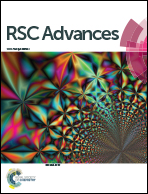Nanosheet-assembled 3D nanoflowers of ruthenium oxide with superior rate performance for supercapacitor applications†
Abstract
Nanosheet-assembled 3D nanoflowers of ruthenium oxide were prepared by a microwave-hydrothermal process without using a template. The 3D nanoflowers consisted of interconnected spheres and had sizes of 250–300 nm. The mechanism of formation of the nanosheet-assembled 3D nanoflowers was determined on the basis of experimental evidence. The specific capacitance of an electrode based on these 3D nanoflowers was calculated and found to be 545.2 F g−1 at a discharging current density of 0.5 A g−1. The unique morphology of the nanoflowers allows H+ ions greater electrochemical access to the pores of the active RuO2 matrix, leading to a high specific capacitance. Moreover, the specific capacitance of the electrode decreased by only 8.6% (from 545.2 to 498.2 F g−1) as the discharging current density was increased from 0.5 to 50 A g−1, indicating its excellent rate capability. This superior rate capability could also be attributed to the porous nature of the nanoflowers. The excellent electrochemical properties of the 3D nanoflowers make them an attractive material for use in electrochemical capacitors.


 Please wait while we load your content...
Please wait while we load your content...